There aren’t many organizations wondering what to do with all of their excess resources. “Gee, we just don’t know how to spend all of this extra money or where to assign all of these employees that just don’t have enough to do” is not a sentiment commonly heard in meeting rooms or staff meetings at agencies providing clean, plentiful water to their customers or at land conservation agencies struggling to preserve land in its natural state in the face of growing development pressure.
Since a successful, sustainable collaborative relationship requires finding common ground, putting two mission-driven organizations that are stretched to capacity – or just beyond! – together in a thoughtful, deliberate manner may be just the ticket to accomplishing more than either entity ever thought possible working in isolation.
But successful collaborative relationships that withstand the test of time require much more than throwing two sets of overworked teams together in the blender and pressing the start button. Smoothies may be satisfying but only last a short time!
Here at the New England Environmental Finance Center we were excited to be part of a conversation that started with a local water utility and a state drinking water bureau discussing how more sources of safe, clean drinking water could be protected in this era of tightening budgets and even tighter staffing levels. The tone of the conversation became more positive than negative as stories seeped out of collaborative relationships that happened more by accident than design among local water utilities and local land conservation groups such as land trusts. Very quickly it became apparent that there were significant benefits to both the water AND land entities. Problem solved? Not so fast.
Although we were able to put our heads together and identify some successful partnerships, this “match made in heaven” seemed to be more the exception rather than the rule. If this arrangement made so much sense and was truly a win-win situation why wasn’t this standard operating procedure? Answering this question became the reason for our existence as a small working group formed to dig deeper into this challenge.
Job one was to determine just how collaborative local water utilities were in our geographic area (New England), and if there was room for improvement. As it turns out, many water utilities have both ongoing collaborative relationships with a variety of partners and have also identified potential teammates to connect with to meet additional unmet needs. We concluded that the landscape, or more precisely, the waterscape was a fertile setting to expand upon when it comes to building sustainable collaborative relationships.
When people think of groups in charge of protecting clean water, most naturally identify water utilities as the main player. Land trusts and conservation groups, municipalities, lake associations, fire departments and other first responders, and schools all play a role – or should play a role – in maintaining a clean supply of water, both for today and in the future. We came up with a graphic after much noodling and doodling that accurately and completely lays these relationships out clearly and succinctly. We call it “The Doughnut of Collaboration” since coffee and doughnuts laid the foundation of our collaboration! More on that later.
As you can see, there are numerous potential partnerships that can exist to help water utilities successfully deliver on their mission. Conserving forests around a water source is key to ensuring clean drinking water and land trusts already do that as part of their mission. Lake associations monitor water quality and educate their members about how to be good water stewards as well as preserve water resources for recreation and tourism development. Municipal governments have significant responsibility and authority over land use planning and enforcement of required development practices and policies, all of which have huge potential impacts on both water quality and quantity. First responders may be the difference between successfully managing an incident, or not, which may negatively impact the safety of the community’s water supply. Educational institutions can accomplish much of the outreach activities so necessary in developing and maintaining broad and deep public support for the mission of a water utility.
The goal that our collaborative working group decided to prioritize was to expand the number of collaborative relationships that exist between water utilities and land conservation groups. Or to put it more simply, get the land and water people together and find out what they know about each other, what issues need to be identified early enough in the relationship so that they don’t cause disruptions down the road, what barriers exist to working together, and finally how to make these collaborations sustainable and not transactional.
To find out what happened when we brought our first group of water AND land people together watch for our next blog post! Until then, just remember that many great collaborations start out over coffee and doughnuts!

